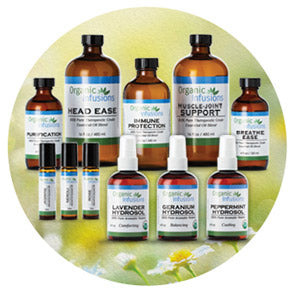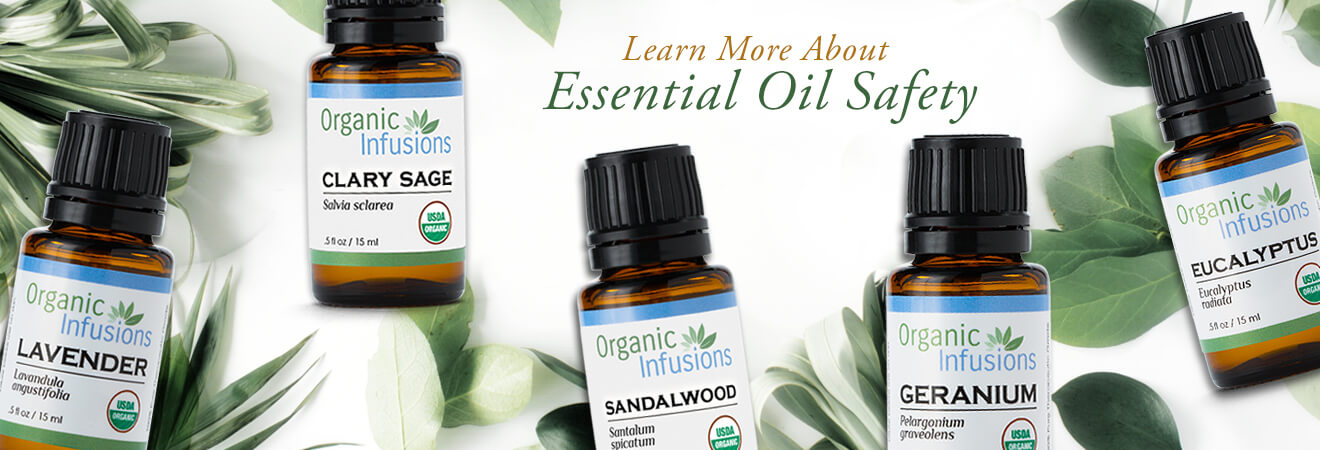All information contained within this site is for reference purposes only and are not intended to substitute the advice given by a pharmacist, physician, or any other licensed health-care professional. Organic Infusions products have not been evaluated by the FDA and are not intended to diagnose, treat, cure, or prevent any health condition or disease.
Safety First - Using Essential Oils
- Never use any essential oils of the citrus variety before sunbathing, for they are considered to be photosensitive oils, especially Bergamot. See table 3 for a list of essential oils to avoid before going into the sun
- Do not use essential oils before the 18th week of pregnancy and then the essential oils should only be blends which have been formulated by a professional health care provider and Certified Clinical Aromatherapist and always in low dilution. Essential oils that appear to be safe include Cardamon, German and Roman Chamomile, Frankincense, Geranium, Ginger, Neroli, Patchouli, Petitgrain, Rosewood, Rose, Sandalwood, and other nontoxic essential oils.16 Before using any essential oils during pregnancy, check with your doctor first. It would also be prudent to avoid the internal or undiluted application of essential oils throughout pregnancy. See table 6 for essential oils to avoid during pregnancy
- Keep aromatherapy products away from children under 12 and pets unless they have been approved on the correct application and usage by their health care provider or veterinarian.
- Never take essential oils internally unless advised by a health care practitioner and Certified Clinical Aromatherapist.
- All essential oils should be diluted with the exception of Tea Tree and Lavender which in most cases can be used directly on the skin (neat), but never on children under 12 or pets.
- Avoid using essential oils when taking homeopathic remedies.
- Reduce or avoid alcohol after aromatherapy massage.
- With high blood pressure, avoid Rosemary, Peppermint, Black Pepper, Clove, Thyme, Hyssop, Sage
- Low blood pressure - avoid excessive use of Lavender oil.
- Epilepsy - avoid Fennel, Hyssop and Rosemary.
Essential Oil Application Therapy on the Skin
General safety guidelines include: avoid application of known dermal irritant essential oils on any inflammatory or allergic skin condition; avoid undiluted application; avoid application on open or damaged skin; and dilute known dermal irritants with appropriate vegetable oil or other carrier. If you suspect your or a client has sensitive skin, perform a skin patch test. Table 1 lists some, but not all, common essential oils considered to be dermal irritants.
Dermal Irritants (Table 1)
|
Essential Oil |
Latin Name |
|
Bay |
Pimento racemosa |
|
Cinnamon bark or leaf |
Cinnamomum zeylanicum* |
|
Clove bud |
Syzygium aromaticum |
|
Citronella |
Cymbopogon nardus |
|
Cumin |
Cuminum cyminum |
|
Lemongrass |
Cymbopogon citratus |
|
Lemon verbena |
Lippia citriodora |
|
Oregano |
Origanum vulgare |
|
Tagetes |
Tagetes minuta |
|
Thyme ct. thymol |
Thymus vulgaris |
*bark is more irritating than leaf
Dermal sensitization
Dermal sensitization is a type of allergic reaction. It occurs on first exposure to a substance, but on this occasion, the noticeable effect on the skin will be slight or absent. However, subsequent exposure to the same material, or to a similar one with which there is cross-sensitization, produces a severe inflammatory reaction brought about by cells of the immune system (T-lymphocytes).7 The reaction will be represented on the skin as blotchy or redness, which may be painful to some individuals.
The best way to prevent sensitization is to avoid known dermal sensitizers and avoid applying the same essential oils every day for lengthy periods of time. Sensitization is, to an extent, unpredictable, as some individuals will be sensitive to a potential allergen and some will not.8
According to Burfield (2004), the following oils listed in Table 2 are considered to be dermal sensitizers and are not recommended for use in aromatherapy massage.
Dermal Sensitizers (Table 2)
|
Essential Oil |
Latin Name |
|
Cassia |
Cinnamomum cassia |
|
Cinnamon bark |
Cinnamomum zeylanicum |
|
Peru balsam |
Myroxylon pereirae |
|
Verbena absolute |
Lippia citriodora |
|
Tea absolute |
Camellia sinensis |
|
Turpentine oil |
Pinus spp. |
|
Backhousia |
Backhousia citriodora |
|
Inula |
Inula graveolens |
|
Oxidized (rancid) oils from Pinaceae family (e.g., Pinus and Cupressus species) and Rutaceae family (e.g., citrus oils) |
|
Photosensitization
An essential oil that exhibits this quality will cause burning or skin pigmentation changes, such as tanning, on exposure to sun or similar light (ultraviolet rays). Reactions can range from a mild color change through to deep weeping burns.
Do not use or recommend the use of photosensitizing essential oils prior to going into a sun tanning booth or the sun. Recommend that the client stay out of the sun or sun tanning booth for at least twenty-four hours after treatment if photosensitizing essential oils were applied to the skin. Certain drugs, such as tetracycline, increase the photosensitivity of the skin, thus increasing the harmful effects of photosensitizing essential oils under the necessary conditions. Table 3 lists some, but not all, common essential oils considered to be photosensitizers.
Photosensitizers (Table 3)
|
Essential Oil |
Latin Name |
|
Angelica root |
Angelica archangelica |
|
Bergamot unless bergaptene free |
Citrus bergamia |
|
Cumin |
Cuminum cyminum |
|
Distilled or expressed grapefruit (low risk) |
Citrus paradisi |
|
Expressed lemon |
Citrus limon |
|
Expressed lime |
Citrus medica |
|
Orange, bitter (expressed) |
Citrus aurantium |
|
Rue |
Ruta graveolens |
Non-phototoxic citrus oils (Table 4)
|
Essential Oil |
Latin Name |
|
Bergamot: Bergapteneless |
Citrus bergamia |
|
Distilled lemon |
Citrus limon |
|
Distilled lime |
Citrus medica |
|
Mandarin - Tangerine |
Citrus reticulata |
|
Sweet orange |
Citrus sinensis |
|
Expressed tangerine |
Citrus reticulata |
|
Yuzu oil (expressed or distilled) |
Citrus juno |
Mucous membrane irritant
A mucous membrane irritant will produce a heating or drying effect on the mucous membranes of the mouth, eyes, nose, and reproductive organs. It is recommended that mucus membrane irritating essential oils not be used in a full body bath unless placed in a dispersant first (e.g., milk, vegetable oil). It would also be wise to put the dispersed essential oils into the water after you have gotten into the bath. Bay, clove, cinnamon bark, lemongrass, and thyme ct. thymol essential oils should be avoided in baths completely. Table 5 lists some, but not all, common essential oils considered to be mucous membrane irritants.
Mucous membrane irritants (Table 5)
|
Essential Oil |
Latin Name |
|
Bay |
Pimento racemosa |
|
Caraway |
Carum carvi |
|
Cinnamon bark or leaf |
Cinnamomum zeylanicum |
|
Clove bud or leaf |
Syzygium aromaticum |
|
Lemongrass |
Cymbopogon citratus |
|
Peppermint |
Mentha x piperita |
|
Thyme ct. thymol |
Thymus vulgaris |
Pregnancy
The use of essential oils during pregnancy is a controversial topic and one that is yet to be fully understood. The main concern during pregnancy appears to be the risk of essential oil constituents crossing over into the placenta. According to Tisserand and Balacs, crossing the placenta does not necessarily mean that there is a risk of toxicity to the fetus; this will depend on the toxicity and the plasma concentration of the compound. It is probable that essential oil metabolites cross the placenta due to the intimate (but not direct) contact between maternal and embryonic or fetal blood. Tony Burfield goes on to say, “to my thinking the responsible attitude is to discourage the use of essential oils completely during the first few months of pregnancy”.10
Due to the lack of clear information regarding the toxicity of essential oils during pregnancy, it would be best to adhere to general safety guidelines. According to Tisserand and Balacs, the following essential oils should not be used during pregnancy: wormwood, rue, oak moss, Lavandula stoechas, camphor, parsley seed, sage, and hyssop.15
Essential oils that appear to be safe include cardamon, German and Roman chamomile, frankincense, geranium, ginger, neroli, patchouli, petitgrain, rosewood, rose, sandalwood, and other nontoxic essential oils.16 It would also be prudent to avoid the internal or undiluted application of essential oils throughout pregnancy.
Essential oils to Avoid throughout Pregnancy, Labor, and while Breastfeeding (Table 6)
|
Essential Oil |
Latin Name |
|
Aniseed |
Pimpinella anisum |
|
Basil ct. estragole |
Ocimum basilicum |
|
Birch |
Betula lenta |
|
Camphor |
Cinnamomum camphora |
|
Hyssop |
Hyssopus officinalis |
|
Mugwort |
Artemisia vulgaris |
|
Parsley seed or leaf |
Petroselinum sativum |
|
Pennyroyal |
Mentha pulegium |
|
Sage |
Salvia officinalis |
|
Tansy |
Tanacetum vulgare |
|
Tarragon |
Artemisia dracunculus |
|
Thuja |
Thuja occidentalis |
|
Wintergreen |
Gaultheria procumbens |
|
Wormwood |
Artemisia absinthium |
General Safety Precautions & Guidelines
1. Keep all essential oils out of reach of children and pets.
2. Do not use or recommend the use of photosensitizing essential oils prior to going into a sun tanning booth or the sun. Recommend that the client stay out of the sun or sun tanning booth for at least twenty-four hours after treatment if photosensitizing essential oils were applied to the skin.
3. Avoid prolonged use of the same essential oils.
4. Avoid the use of essential oils you know nothing about on yourself or your clients. Research and get to know the oil prior to using it.
5. Avoid the use of undiluted essential oils on the skin, unless otherwise indicated.
6. If you suspect you or your client may be sensitive to specific essential oils or if your or your client has known allergies or sensitivities, it may be wise to perform a skin patch test.
7. Know the safety data on each essential oil and place into context of use and knowledge.
8. Use caution when treating a female client who suspects she is pregnant or has been trying to become pregnant.
9. Keep essential oils away from the eyes.
10. Essential oils are highly flammable substances and should be kept away from direct contact with flames, such as candles, fire, matches, cigarettes, and gas cookers.17
11. Make sure your treatment room has good ventilation.
12. Do not use essential oils internally or advice on the use of essential oils internally unless you have been properly trained in one of NAHA’s approved schools and you have met the required hours of training to do so. At this point, only those who have graduated and become a Clinical Aromatherapist have the training to prescribe essential oils. If you advice on the use of essential oils for internal use and are not a Certified Clininal Aromatherapist, you are practicing medicine without a license and it is illegal.
Safety Measures
1. If essential oil droplets accidentally get into the eye (or eyes) a cotton cloth or similar should be imbued with a fatty oil, such as olive or sesame, and carefully swiped over the closed lid.18 And / Or, Immediately flush the eyes with cool water.
2. If an essential oil causes dermal irritation, apply a small amount of vegetable oil or cream to the area affected and discontinue use of essential oil or product that has caused dermal irritation.
3. If a child or animal appears to have drunk several spoonfuls of essential oil, contact the nearest poison control unit (often listed in the front of a telephone directory). Keep the bottle for identification and encourage the child to drink whole or 2% milk. Do not try to induce vomiting.19
Used with permission by NAHA (National Association for Holistic Aromatherapy)
All information contained within this site is for reference purposes only and are not intended to substitute the advice given by a pharmacist, physician, or any other licensed health-care professional. Organic Infusions products have not been evaluated by the FDA and are not intended to diagnose, treat, cure, or prevent any health condition or disease.








